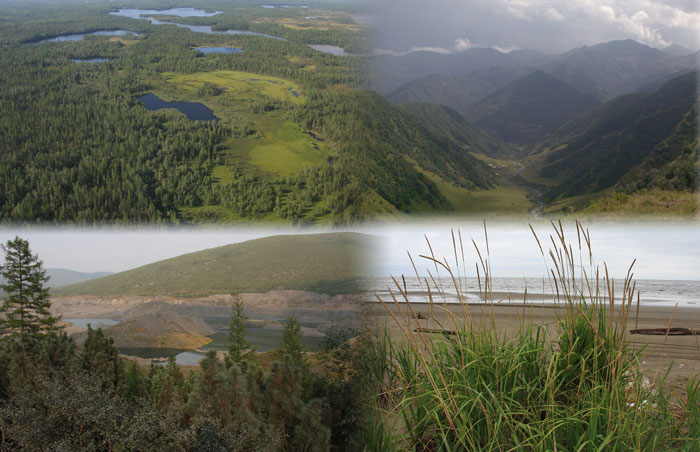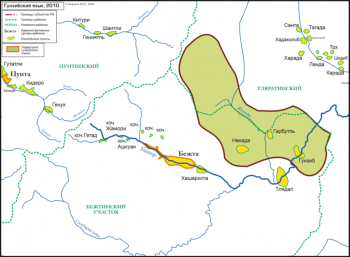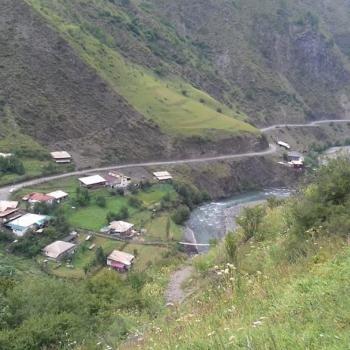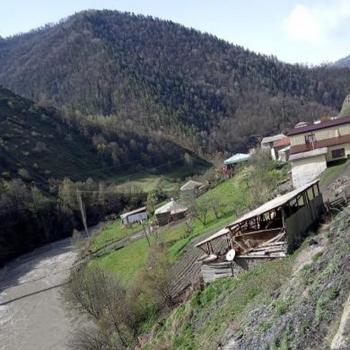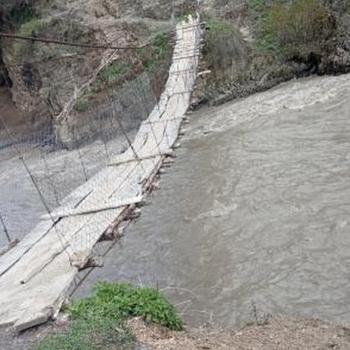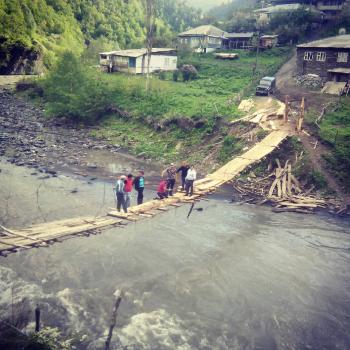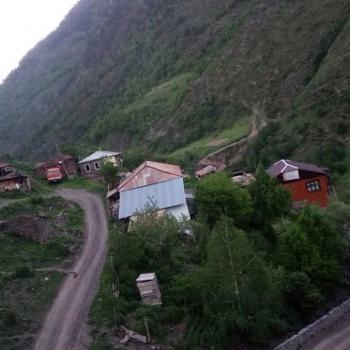Brief Information
The Hunzib people are primarily located in Tsuntinsky District, in several mountainous villages Gunzib, Garbutli, Nakhada, Rodor, Todor and on the plains in Stal’skoe, Komsomol’skoe and Šušanovka (Kizilyurtovsky raion) of the Republic of Dagestan, as well as in the Saruso village of the Kvareli District in Georgia.
According to the 2010 census, 1012 speakers of Hunzib are in Russia. The actual number of speakers is about 2000 in Russia, and about 400 in Georgia.
Hunzib does not have dialects, but there are some small differences in grammar and lexicon in the speech of Gunzib, Garbutli and Nakhada speakers.
Hunzib was known under several names, which were Enzebi, Nakhada, Bezhta-Hunzib, Kapucha-Hunzib and Khvan. Enzebi is the Georgian name for Hunzib. Hunzib is the Avar name. Gunzibskiy yazyk is the Russian name for the language.
Traditional occupations are cattle breeding, agriculture, hunting, fishing and beekeeping.
Traditionally the Hunzib people compactly reside in the mountainous area. Due to the resettlement in the Soviet times, the Hunzib people are also found in the lowland area: in the villages of the Kizilyurt, Kizlyar and Tarumovsky Districts (Stalskoe, Shushanovka, Komsomolskoe, Alexandriiskaya, Malaya Areshevka and Aleksandro-Nevskaya), where they live in mixed communities.
All Hunzib people are Sunni Muslims.
Genealogy
The Hunzib language does not have dialectal variations. There can be distinguished local varieties in the villages of Gunzib, Garbutli and Nakhada.
the Gunzib village, Tsuntinsky District (Dagestan, Russia)
the Nahada village, Tsuntinsky District (Dagestan, Russia)
the Garbutli village, Tsuntinsky District (Dagestan, Russia)
the Stalskoe village, Kizilyurt District (Dagestan, Russia)
the Komsomolskoye village, Kizilyurt District (Dagestan, Russia)
the Shushanovka village, Kizilyurt District (Dagestan, Russia)
Alexandriiskaya, Kizlyar District (Dagestan, Russia)
Malaya Areshevka, Kizlyar District (Dagestan, Russia)
the Aleksandro-Nevskaya village, Tarumovsky District
the Tkhilistskaro village (Kakheti, Georgia)
the Saruso village (Kakheti, Georgia)
Dialects and their distribution
Language contacts and multilingualism
The Hunzib people are fluent in Avar and Russian. Some Hunzibs know or have passive knowledge of Bezhta. Georgian is only spoken by immigrants from Georgia and by the Hunzibs living in Georgia. Only children of early preschool age are monolinguals.
Language functioning
- Legal status
- Writing system
- Language standardization
- Domains of language usage
The Hunzib language has no official status. In the Constitution of Dagestan, it’s defined as one of the languages of the peoples of Dagestan that has no writing system.
Hunzib does not have an officially established writing system. Avar and Russian are generally used as written languages.
Hunzib does not have a standardized language variant. The Hunzib speakers use their own language varieties when communicating with each other.
Family / everyday communication
Family / everyday communication
Hunzib is used in family and everyday communication.
Education
Education
Hunzib is not a subject of study in any educational institutions. Avar is taught as “a native language” to Hunzib pupils.
In rural preschool and in primary rural schools, Hunzib is used as a means of communication with children.
There are no textbooks and manuals in Hunzib.
Mass media
Mass media
Hunzib is not used in mass media.
Culture
Culture
There are no movies or theatre performances in Hunzib.
Science
Science
Hunzib is not the language of science. It is used only in scientific literature as an illustrative example.
Folklore
Folklore
There is no folkloric work in Hunzib.
Literature
Literature
There is no literature created in Hunzib.
Religion
Religion
Arabic and Avar are used in religion. In some rituals and chants, Hunzib is used.
Legislation
Legislation
Hunzib is not used in official legislation documents.
Administrative activities
Administrative activities
Hunzib is not used in administrative activities.
Legal proceedings
Legal proceedings
The language of legal proceedings in Dagestan is Russian.
Industry
Industry
Hunzib is not used industrial production.
Agriculture
Agriculture
Hunzib is used during fishing, haymaking and etc.
Trade and service
Trade and service
Hunzib is used in small shops, cafes, hotels and markets in Hunzib-speaking villages.
Transport
Transport
Hunzib is used in taxis running between regional centers and the Hunzib villages.
Internet
Internet
There are no official websites, chats or groups in social media in Hunzib.
Dynamics of language usage
Hunzib remains the main means of communication in the community. Many Hunzibs consider themselves Avars, an ethnic group with a more prestigious status in the Dagestan Republic. At the same time, the knowledge of Avar among the Hunzib people is decreasing year by year due to the spread of the mass media in Russian. Nowadays, more Hunzib people can speak Russian than Avar.
The level of Hunzib language proficiency in rural areas is quite high. The language transmission to children in rural areas still continues. The language proficiency among the younger generation in urban areas is declining.
Language structure
Phonetics
There are 24 vowels and 35 consonants in Hunzib.
Phonetics
There are 24 vowels and 35 consonants in Hunzib.
Vocalic system
Unlike other Tsez languages, Hunzib is characterized by complex and archaic vocalism with a developed middle row. There are 24 vowel phonemes in Hunzib: simple ones - i, e, ə, ɨ, u, o, a, ɑ, nasalized ones - in, en, ən, ɨn, un, on, an, ɑn, long ones - i:, ɨ:, a: , e:, u:, o:, ǝ:.
Consonant system
The most common oppositions for Hunzib consonants are voiced and voiceless, ejective and non-ejective consonants. The plosives have the following triads (voiced, voiceless, ejective): b — p — p’, d — t — t’, g — k — k’. The affricates have the opposition of ejective and non-ejective consonants: c — c’, č — č’, ƛ — ƛ’, q — q’. The fricatives have the voiced and voiceless opposition: z — s, ž — š, ʁ — χ, ʔ — h. The unpaired fricatives: w, ɬ, j. The sonorants — m, n, r, l. Phonemes /x/, /ħ/ and /ʕ/ are only found in loans.
One of the main phonetic processes is assimilation, e.g. χor ‘sheep’ (singular) > χor-la / χol-la ‘sheep’ (plural), mesed ‘gold’> mesed-li / meselli ‘gold.OBL’. Vowel deletion often occurs in the oblique stem formation in nouns, e.g. bɨcu ‘hand’ and bɨc-la ‘hands’.
Common syllable types are of CV, CVC structure. Consonant clusters are disallowed in the language. Avar borrowings are often of CVCR syllable structure, with R being a resonant.
There is no word stress in Hunzib. The phrasal emphasis is usually on the first syllable.
Morphology
Hunzib morphology is agglutinative, with some elements of fusion.
Morphology
Hunzib belongs to the agglutinative type having rich nominal and verbal morphology, but with some elements of fusion (in word formation) and analytics (in structure of some separate verb forms). There are the following parts of speech: nouns, adjectives, numerals, pronouns, verbs, adverbs, postpositions, particles and interjections.
Hunzib nouns inflect for case and number. The category of gender is covert. When nominalized, adjectives, numerals and pronouns of certain categories also inflect for cases and numbers.
Unlike other Tsezic languages, Hunzib has a relatively simple locative system. It includes seven series of localization and three orientational cases: essive case expressing ‘absence of motion’, ablative case expressing ‘motion out of smth’, translative case with the meaning ‘motion through’. Directional case occurs only with few localization markers.
Hunzib verbs consists of a stem, which can be preceded by a gender-number prefix and followed by endings. Hunzib has a large number of non-finite verb forms, converbs, participles, masdar and infinitive.
The numeral system is decimal.
The main ways of word formation in Hunzib are suffixation, composition, reduplication and conversion.
Syntax
Hunzib is an ergative language. The basic word order is subject-predicate-object (SOV).
Syntax
Hunzib is an ergative language. It is a left-branching SOV language with relatively free word order.
Complex sentences are formed by non-finite forms. The participles are used as the head of a relative clause. Numerous converbs are used in adverbial constructions. Infinitives, masdars and participles are used in complement clauses.
Vocabulary
The Hunzib vocabulary consists of inherent and borrowed verbs.
Vocabulary
Most of the basic vocabulary in Hunzib is of common East Caucasian origin. Borrowings are from Avar, Arabic, Georgian, Russian, Turkic and Persian languages.
Исследование языка
‘Analiz Kapučinsko-gunzibskogo jazyka’ by Lomtadze (1956) is the first description of Hunzib. Bokarev’s monograph of the Tsezic languages (1959) is another important publication. ‘A grammar of Hunzib (with texts and lexicon)’ by van den Berg (1995) is a grammatical description with dictionary and a collection of texts in English.
Other important publications are ‘Hunzib-Russian dictionary’ by Isakov & Khalilov (2001), and a comprehensive description of the phonology and morphology of Hunzib by Isakov & Khalilov (2012).
Language experts
Madzhid Khalilov
Author of a number of works on phonetics, morphology, word formation and lexicology of the Tsezic languages. Co-author of the first Hunzib dictionary (2001), as well as of the Hunzib grammar (2012).
Research centres
Institute of Language, Literature and Arts of the Dagestan Federal Research Centre of the Russian Academy of Sciences
Madzhid Khalilov, an employee at the Institute of Language, Literature and Arts of the Dagestan Federal Research Centre of the Russian Academy of Sciences, specializes in the Tsezic languages.
Core references
Grammatical descriptions: grammars, sketches
Bokarev E.A. Gunzibskiy yazyk. [The Hunzib Language]. //Yazyki narodov SSSR. Vol. 4. Moscow, 1967.
Bokarev E.A. Tsezskie (didoyskie) yazyki Dagestana. [The Tsez (Didoic) Languages of Dagestan]. Moscow: Izd-vo AN SSSR, 1959.
Isakov I.A. Gunzibskiy yazyk. [The Hunzib Language]. //Yazyki mira: Kavkazskie yazyki. Moscow, 1998. Pp. 53-62.
Isakov I.A. Gunzibskiy yazyk. [The Hunzib Language]. //Yazyki narodov Rossii: Yazyki Dagestana. Makhachkala; Moscow, 2000.
Isakov I.A., Khalilov M.Sh. Gunzibskiy yazyk (Fonetika. Morfologiya. Slovoobrazovanie. Leksika. Teksty). [The Hunzib Language (Phonetics. Morphology. Word formation. Vocabulary. Texts)]. Makhachkala, 2012.
Isakov I.V., Khalilov M.Sh. Hinukh. // The Indigenous Languages of the Caucasus. – Michigan, U.S.A., 2004. – Vol. 3.
Helma van den Berg. A Grammar of Hunzib (with Texts and Lexicon) – Munich/Newcastle: Lincom Europa, 1995.
Dictionaries
Isakov I.A., Khalilov M.Sh. Gunzibsko-russkiy slovar'. [Hunzib-Russian dictionary]. Moscow: Nauka, 2001.
Selected papers on grammatical issues
Gamzatov R.E. Struktura sloga i slogodelenie v gunzibskom yazyke. [Structure and Division of Syllables in the Hunzib Language] // Slovo i slovosochetanie v yazykakh razlichnykh tipov. Moscow, 1973.
Isakov I.A. O gunzibskom kauzativnom glagole. [On the Hunzib Causative Verbs]. // Nauchnaya sessiya, posvyashchennaya itogam ekspeditsionnykh issledovaniy Instituta IYaL v 1982–1983 gg.: tezisy dokladov.. Makhachkala, 1984.
Isakov I.A. Glagol'noe slovoobrazovanie v gunzibskom yazyke. [Verb formation in the Hunzib language] // Voprosy slovoobrazovaniya dagestanskikh yazykov. - Makhachkala, 1986.
Isakov I.A. Vopros o masdarakh v gunzibskom yazyke. [The Question of Masdars in the Hunzib Language]. // Otglagol'nye obrazovaniya v iberiysko-kavkazskikh yazykakh: tezisy dokladov XII regional'noy nauchnoy sessii po izucheniyu iberiysko-kavkazskikh yazykov. - Cherkessk; Karachay-Cherkessia, 1988.
Kibrik A.E. Materialy k tipologii ergativnosti (Bezhtinskiy yazyk. Gunzibskiy yazyk. Tsezskiy yazyk. Ginukhskiy yazyk). [Materials for the ergative typology (Bezhta language. Gunzib language. Tsez language. Ginukh language). Moscow, 1981.
Kodzasov S.V., Kibrik A.E. Sopostavitel'noe izuchenie dagestanskikh yazykov. Imya. Fonetika. [Comparative Study of Dagestani Languages. Name. Phonetics]. Moscow: Izdatel'stvo Moskovskogo universiteta. 1990 – 366 p.
Comrie, B., Forker, D., & Khalilova, Z. 2012. Adverbial clauses in the Tsezic languages. In V. Gast, & H. Diessel (Eds.), Clause Linkage in Cross-Linguistic Perspective. Berlin: de Gruyter, pp. 157-190.
Comrie, B., Diana F. & Khalilova, Z. 2018. Affective constructions in Tsezic languages. In Barðdal, Jóhanna, Na'ama Pat-El and Stephen Mark Carey (eds.) Non-Canonically Case-Marked Subjects. The Reykjavík-Eyjafjallajökull papers. Amsterdam: Benjamins.
Comrie, B., Forker, D., Khalilova Z., and †Helma van den Berg, 2020. Antipassives in Nakh-Daghestanian Languages: Exploring the Margins of a Construction. In Katarzyna Janic and Alena Witzlack-Makarevich (eds), The Multifaceted Nature of Antipassive (Typological Studies in Language). Amsterdam: John Benjamins.
Работы по этнологии
Shilling E.M. Narody ando-tsezskoy gruppy. [Peoples of the Ando-Tsez Group] // Panek L.B., Shilling E.M. Sbornik ocherkov po etnografii Dagestana. Makhachkala, 1996. Pp. 21-38.
Rizakhanova M.Sh. Gunzibtsy. XIX – nach. XX veka: Istoriko-etnograficheskoe issledovanie. [The Hunzibs. XIX - early XX century: Historical and Ethnographic Research]. Makhachkala, 2001.
Resources
Corpora and text collections
There is no public electronic corpus of Hunzib.
The Intercontinental Dictionary Series
There are 1529 lexical entries of Hunzib on the webpage of the project.
Data for this page kindly provided by
Zaira M. Khalilova (Institute of Linguistics. RAS, Moscow).
Sources:
Helma van den Berg. A Grammar of Hunzib (with Texts and Lexicon). – Munich/Newcastle: Lincom Europa, 1995.
Bokarev E.A. Gunzibskiy yazyk. [The Hunzib Language]. // Yazyki narodov SSSR. Vol. 4. Moscow, 1967.
Isakov I.A., Khalilov M.Sh. Gunzibskiy yazyk (Fonetika. Morfologiya. Slovoobrazovanie. Leksika. Teksty). [The Hunzib Language (Phonetics. Morphology. Word formation. Vocabulary. Texts)]. Makhachkala, 2012.
Kodzasov S.V., Kibrik A.E. Sopostavitel'noe izuchenie dagestanskikh yazykov. Imya. Fonetika. [Comparative Study of Dagestani Languages. Name. Phonetics]. Moscow: Izdatel'stvo Moskovskogo universiteta. 1990 – 366 p.
Rizakhanova M.Sh. Gunzibtsy. XIX – nach. XX veka: Istoriko-etnograficheskoe issledovanie. [The Hunzibs. XIX - early XX century: Historical and Ethnographic Research]. Makhachkala, 2001.
Testelets J.G. Gunzibskiy yazyk. [The Hunzib Language]. // Bol'shaya rossiyskaya entsiklopediya. Electronic version (2018); https://bigenc.ru/linguistics/text/5200073


